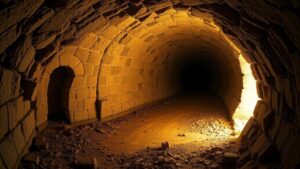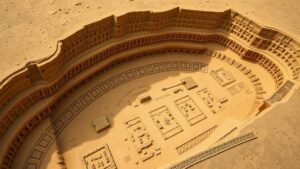Investigating the possibility of ancient subterranean cities beneath the mountains of Tibet.
Investigating the Possibility of Ancient Subterranean Cities Beneath the Mountains of Tibet
The rugged terrain of Tibet has long captivated explorers, archaeologists, and historians alike. This region, often referred to as the Roof of the World, is characterized by towering mountains, vast plateaus, and a rich tapestry of culture and history. One of the most intriguing theories gaining attention in recent years is the existence of ancient subterranean cities hidden beneath the mountains of Tibet. This article delves into the evidence supporting this theory, explores historical context, and examines the implications of such discoveries.
The Geology of Tibet: A Potential Hiding Place
The Tibetan Plateau, which stretches over 2.5 million square kilometers, is the highest and largest plateau on Earth. Its unique geological formations, including deep valleys and mountainous regions, suggest a landscape ripe for habitation throughout history. Research indicates that these mountains have undergone significant geological changes, potentially creating caverns and tunnels ideal for the construction of subterranean cities.
- The Tibetan Plateau was uplifted more than 50 million years ago as a result of tectonic plate collisions. This history of geological upheaval may have created natural caves and hollow spaces within the mountains.
- Some local legends speak of hidden cities, suggesting that ancient civilizations might have utilized these subterranean spaces for refuge or habitation.
Historical Context: Ancient Civilizations in Tibet
Tibet boasts a rich cultural history that dates back thousands of years. The region is known as the heart of Tibetan Buddhism, and ancient trade routes crisscrossed the area, indicating that it was a vibrant hub of activity. Some historical accounts–including those from Tibetan texts–suggest that advanced civilizations may have existed and thrived in these remote areas.
- In the 7th century, King Songtsen Gampo unified Tibet and is credited with bringing Buddhism from India. His reign possibly coincided with urban planning that utilized subterranean methodologies.
- Archaeological findings in nearby regions, such as the ruins at ancient Zhangzhung, hint at complex societies with extensive knowledge of architecture and engineering.
Evidence for Subterranean Cities
While definitive proof of subterranean cities in Tibet is presently lacking, several intriguing leads warrant further investigation. Reports from explorers and researchers have uncovered various claims of hidden structures and tunnels beneath the surface.
- In 2016, a group of explorers claimed to have discovered an alleged cave system that contained intricate carvings and artifacts, although this was met with skepticism by the academic community.
- Geological surveys using ground-penetrating radar–conducted since the late 1990s–have detected unusual anomalies beneath the surface of some Tibetan mountains, igniting speculation about hidden chambers.
The Role of Modern Technology in Exploration
Advancements in technology have provided new avenues for potential discovery. High-resolution satellite imagery, drone technology, and ground-penetrating radar equipment enable researchers to survey vast and difficult landscapes more efficiently than ever before. e methods can help identify potential sites for excavation and study with minimal disruption to the environment.
- For example, satellite imagery has revealed unexplained geometrical patterns in the landscape that may suggest human intervention.
- Technological advances allow for non-invasive exploration methods, reducing the potential environmental impact while seeking out ancient structures.
Cultural Implications
The discovery of ancient subterranean cities would not only reshape our understanding of Tibetan history but could also challenge global perspectives on ancient civilizations. This would prompt a reevaluation of trade, cultural exchanges, and technological advancements in pre-modern societies. Exploring these connections can illuminate the widespread influence and remarkable adaptability of ancient peoples.
- Such findings could reveal a longer continuum of habitation and cultural continuity in the region, impacting the narrative of Tibetan identity.
- If tangible evidence is found, it may foster greater interest in preserving unique cultural sites and understanding their significance to local communities.
Conclusion: A Call for further Research
The possibility of ancient subterranean cities beneath the mountains of Tibet invites curiosity and investigation. While definitive evidence remains elusive, the combination of geographical factors, historical context, and modern technology fuels the investigation. The stories of these hidden civilizations resonate with our enduring quest for knowledge and understanding of human history.
As we explore this enigmatic frontier, researchers and adventurers alike are urged to approach the topic with a commitment to scientific rigor and cultural sensitivity. The potential for uncovering a rich tapestry of history lies just beneath the surface, awaiting discovery.



